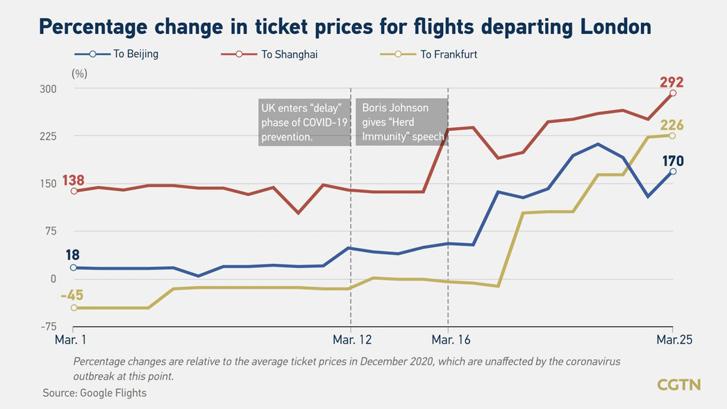Navigating the Skies: Understanding Airfare Price Trends in a Dynamic World
Introduction
Air travel has become an integral part of modern life, connecting people, cultures, and economies across the globe. However, the cost of flying can be a significant barrier for many. Airfare prices fluctuate constantly, influenced by a complex interplay of factors. This article delves into the dynamics of airfare price trends, examining the key drivers, recent patterns, and strategies for savvy travelers seeking the best deals.
The Multifaceted World of Airfare Pricing
Airfare pricing is not a simple calculation. Airlines use sophisticated algorithms to determine ticket prices, considering a wide array of variables. Here are some of the most influential:
- Supply and Demand: This is the most fundamental driver. High demand for a particular route or during peak travel seasons (holidays, summer) will invariably lead to higher prices. Conversely, lower demand often results in discounted fares.
- Fuel Costs: Fuel is a major expense for airlines. Fluctuations in oil prices directly impact airfares. When fuel prices rise, airlines typically pass on at least a portion of the increased cost to passengers.
- Competition: The level of competition on a route significantly affects pricing. Routes with multiple airlines competing for passengers tend to have lower fares compared to those dominated by a single carrier.
- Time of Booking: As a general rule, booking further in advance often yields better prices. However, there can be exceptions, such as last-minute deals aimed at filling empty seats.
- Day of the Week: Historically, Tuesdays and Wednesdays have been considered the cheapest days to fly. While this is not always the case, flying on less popular days can sometimes result in savings.
- Seasonality: Airfares tend to be higher during peak travel seasons, such as summer and holidays. Shoulder seasons (spring and fall) often offer more affordable options.
- Airline Strategy: Airlines employ various pricing strategies, including dynamic pricing (adjusting prices in real-time based on demand), fare classes (different levels of service and flexibility), and ancillary fees (charges for baggage, seat selection, etc.).
- Economic Factors: Overall economic conditions, such as inflation, interest rates, and currency exchange rates, can indirectly influence airfare prices.
Recent Trends and Influences
The past few years have been particularly volatile for the airline industry, with airfare prices experiencing significant fluctuations. Several factors have contributed to these trends:
- COVID-19 Pandemic: The pandemic had a profound impact on air travel, initially causing a sharp decline in demand and prices. As travel restrictions eased, demand surged, leading to a rebound in airfares.
- Inflation and Economic Uncertainty: Rising inflation and economic uncertainty have put pressure on airlines to increase prices to offset rising costs.
- Fuel Price Volatility: Geopolitical events and supply chain disruptions have led to significant fluctuations in fuel prices, impacting airfares.
- Labor Shortages: Many airlines have faced labor shortages, particularly among pilots and ground staff, which has led to flight cancellations and higher prices.
Examples of Recent Data
- According to a recent report by the Bureau of Transportation Statistics, domestic airfares in the United States increased by an average of 25% in 2022 compared to 2021.
- A study by Hopper, a travel booking app, found that international airfares were up by an average of 30% in the first half of 2023 compared to the same period in 2019.
- Data from IATA (International Air Transport Association) shows that passenger demand has continued to recover, but airlines are still facing challenges related to profitability and cost control.
Expert Opinions
"Airfare pricing is incredibly complex," says John Smith, a travel industry analyst. "It’s not just about supply and demand. Airlines are constantly adjusting their prices based on a multitude of factors, including competitor pricing, fuel costs, and even weather forecasts."
Tips for Finding Affordable Airfares
While airfare prices can be unpredictable, there are several strategies that travelers can use to find better deals:
- Be Flexible with Travel Dates: If possible, be flexible with your travel dates. Flying on less popular days or during shoulder seasons can often result in significant savings.
- Book in Advance (But Not Too Early): Booking too far in advance can sometimes be counterproductive, as airlines may not have fully optimized their pricing strategies. Aim to book 2-3 months in advance for domestic flights and 3-6 months in advance for international flights.
- Use Flight Comparison Websites: Utilize flight comparison websites like Google Flights, Kayak, Skyscanner, and Momondo to compare prices from different airlines and travel agencies.
- Set Price Alerts: Many flight comparison websites allow you to set price alerts for specific routes. You’ll receive notifications when the price drops.
- Consider Alternative Airports: If possible, consider flying into or out of alternative airports. Smaller, regional airports often have lower fares.
- Be Open to Connecting Flights: Non-stop flights are typically more expensive than connecting flights. If you’re willing to endure a layover, you can often save money.
- Take Advantage of Airline Sales: Sign up for email newsletters from airlines to stay informed about sales and promotions.
- Use Miles and Points: If you have airline miles or credit card points, consider using them to book your flight. This can be a great way to save money, especially during peak travel seasons.
- Clear Your Browser Cookies: Airlines and travel sites sometimes track your searches and may increase prices if they see that you’re repeatedly searching for the same flight. Clearing your browser cookies can help you avoid this.
- Consider Budget Airlines: While they may not offer all the frills of traditional airlines, budget airlines can be a great option for saving money, especially on shorter routes.
Conclusion
Airfare pricing is a dynamic and complex landscape, influenced by a multitude of factors. By understanding the key drivers of airfare price trends, staying informed about recent patterns, and employing smart booking strategies, travelers can increase their chances of finding affordable flights and making their travel dreams a reality.


Leave a Reply